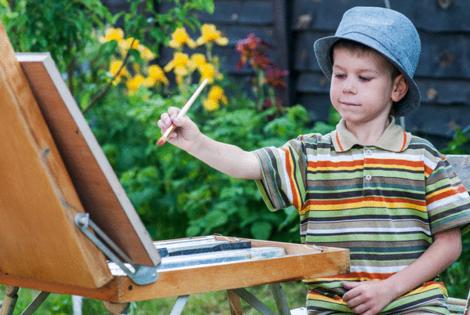Ask the Pediatrician: Using nature, art as outdoor inspiration to boost your child's development
Published in Health & Fitness
Spending time outside, especially in green spaces like parks, is important for children's development and well-being. Connecting with nature can even help manage some physical and mental conditions.
Art also supports a child's development in meaningful ways. Art projects and other forms of play let them explore, interact with and make sense of the world around them. When combined with time outdoors, these creative activities can be even more enriching for kids.
Here are some age-based nature art ideas to help you get started.
For toddlers and preschoolers, focus on tactile or sensory exploration activities like finger painting with mud, stamping with leaves, or drawing in the dirt with sticks. It's all about the experience. At about age 3, you can introduce simple tools like safety scissors to cut leaves or hole-punch fallen flower petals for fun textures.
Scribble tracing can be a great activity for toddlers to explore nature and their creative side. Collect items like leaves, interesting seed pods, textured rocks, shed feathers, pine cones and shells. Hold a blank piece of paper in place on top of the item and invite your toddler to scribble with crayons on the paper, over the item, to reveal the textures.
Encourage them to use different colors with the scribble, and ask which color is their favorite. This activity will work on gross motor skills as they collect the items and fine motor skills as they color over the items. It will also develop their cognitive skills with color identification. Have your preschooler practice using scissors by cutting out their favorite designs. Then, they can glue those onto another paper in a collage.
Using twigs, leaves, grass and string to build a little sculpture can be another activity. Or, grab a paper plate, add some glue and let kids create a masterpiece from collected items like flower petals, bark or pine cones.
School-aged children have a bit more agency than their younger peers. Let them plan a project. Maybe they can design animal masks from natural materials, for example, or illustrate a story about a bird, bunny or other animal they see.
Sidewalk chalk is an inexpensive and popular way to keep younger kids engaged while they get creative on a sidewalk or other hardtop area. Make sure they are safe from traffic or other dangers as children this age may get easily distracted.
Encourage your child to draw the nature they see around them or think about other colorful ideas, such as rainbows, cars or abstract designs.
Rock painting can elevate the fun of sidewalk chalk drawing. Hunt for smooth rocks that are easy to carry or use shells you have collected. Using washable paints and small paintbrushes or color markers, have your child decorate the rocks or shells. Challenge them to use many colors and designs. You may need to help your little one plan to add more features after the first layer dries. Your child can display these new treasures at home or share them with family members, friends and neighbors. Pine cones and larger seed pods can also be painted and decorated.
Sticky leaf collages can help teach children about different plants in their natural surroundings. For this project, you will need clear contact paper and some favorite leaves or petals your child collects. Cut off a sheet of the clear, sticky plastic film; peel the backing off; and have your child place their leaves, petals and whatever flat, natural elements they collected onto the sheet. Then cut another piece, roughly the same size; remove the backing; and place the sticky side down onto the art.
Your child can create a frame cut out of construction paper or thin cardboard to highlight the art. Then, staple or glue this onto the sheets. Or, place the paper frame onto the sticky contact paper first, then add your nature bits to the middle, before applying the second piece of contact paper on top.
As children measure and plan out the frame, they not only practice motor skills but also sharpen cognitive and math skills.
Flower pressing offers another version of the sticky leaf collage. To press flowers, you will need paper towels, a piece of paper that you want to mount the flowers on, lots of newspapers, two boards (you can use plywood or cutting boards), and heavy items such as big books and rocks. Layer these items from bottom to top as follows – a heavy board, thick stack of newspapers, a nice sheet of paper for the flowers to be mounted on, the flowers to be pressed, a couple sheets of paper towels, and then another layer of newspapers and another heavy board with the final layer of heavy objects like books or large rocks.
Wait at least 1 to 2 weeks before taking the press apart to check on the flowers. It is often harder for younger kids to wait a long time. If that is the case, consider gluing flowers and their leaves and petals directly to paper.
As kids get older, they can incorporate technology into their nature excursions. One way to do this is through nature photography.
Digital cameras have made it much easier for children to take pictures. The instant gratification of immediately seeing a photo also works well for children. There are also digital cameras specifically made for younger children, with heavy-duty cases that withstand being dropped, but cell phone cameras work well too.
Consider repurposing an old cell phone or tablet (without cellular or Wi-Fi service) for your child to use for photography. Encourage your child to experiment with beautiful vistas or even different perspectives in nature such as taking a picture of a friend "holding up" the moon.
Encourage your child to "collect" nature with photos that keep a record of birds spotted, wildflowers seen, phases of the moon, and interesting clouds and sunsets. Be sure to ask why they chose to photograph that part of nature. Help them make digital or print albums of their favorites or use graphic design software to create digital art from the photographs.
Here are a few more tips to try with budding nature artists:
--Explore Native American art with your child, focusing on how it honors nature through symbols and storytelling.
--Visit museums and other exhibits of art from different cultural traditions.
--Get inspired by looking at nature photos or nature themed books together.
--Use watercolors outdoors like the impressionists. Capture how light changes a tree or a flower across a day.
--Set up outdoor art stations: On warm days, use an old sheet or cardboard as a canvas outside. Let kids paint with brushes made from leaves or grass.
--Create a seasonal art "exhibit." Devote a wall or shelf to your child's nature-inspired creations. Rotate with the seasons.
By combining the beauty of the outdoors with creative, hands-on activities, you give your child a powerful opportunity to learn, grow and connect with the natural world. These moments foster not just artistic expression but also important cognitive and motor development.
Best of all, these activities create shared memories and invite a sense of wonder that your child will carry with them. So grab some supplies, step outside and let nature be your child's first art teacher.
____
About the authors
Pooja Sarin Tandon, MD, MPH, FAAP, is co-author of the American Academy of Pediatrics book, “Digging Into Nature: Outdoor Adventures for Happier and Healthier Kids.” Dr. Tandon is a member of the AAP Council on Community Pediatrics and a general pediatrician and researcher at the Seattle Children's Research Institute. She also serves as an associate professor at the University of Washington's School of Medicine, and Director of Health at the Trust for Public Land. Dr. Tandon has published widely on the importance of physical activity, outdoor time and nature contact for health.
Danette Swanson Glassy, MD, FAAP, is a member of the American Academy of Pediatrics Councils on Community Pediatrics and Early Childhood and co-author of “Digging Into Nature: Outdoor Adventures for Happier and Healthier Kids.” A primary care pediatrician and child advocate, Dr. Glassy is co-founder and board president of the not-for-profit BestStart Washington and leads its Project Nature initiative—a program to support pediatric medical providers as they encourage children to spend time in nature. She is the co-editor of “Caring for Our Children: National Health and Safety Performance Standards; Guidelines for Early Care and Education Programs, 4th edition.”
©2025 Tribune Content Agency, LLC.










Comments